
One of the cornerstones of adaptive strategy is agility. As markets evolve, technologies advance, and customer demands shift, organizations must adapt quickly to stay ahead of the curve. However, achieving agility requires more than just reacting swiftly to change—it demands a foundation of organizational alignment.
The blog article dives into the crucial role of organizational alignment in fostering agility within businesses. It explores two prominent methodologies— Objectives and Key Results (OKRs) and V2MOM (Vision, Values, Methods, Obstacles, Measures) — and compares their approaches to achieving alignment. By aligning organizational goals and strategies with these methodologies, businesses can not only adapt to changes in the market landscape but also thrive in the face of uncertainty, driving forward with confidence and resilience.
The Importance of Organizational Alignment
Organizational alignment is the glue that holds a business together, ensuring that every team member is moving in the same direction towards common goals. When everyone is aligned, decision-making becomes more efficient, communication flows smoothly, and resources are used effectively. This alignment is what enables businesses to pivot rapidly in response to shifting market dynamics and emerging opportunities.
According to a survey conducted by McKinsey & Company in 2018, companies with strong alignment between their business and technology strategies are 1.5 times more likely to achieve their goals and drive higher financial performance. Additionally, a study by Gallup in 2017 found that organizations with high levels of employee alignment experience 21% higher profitability and 17% higher productivity.
Objectives and Key Results (OKRs)
OKRs, championed by industry giants like Google, emphasize setting ambitious objectives and defining measurable key results to track progress. The methodology is results-oriented, aiming to drive focus, accountability, and transparency across the organization. OKRs are typically set quarterly, encouraging adaptability and agility in response to changing priorities and market conditions.
Key Characteristics of OKRs:
Focus: OKRs prioritize clarity and focus, ensuring that teams concentrate their efforts on the most impactful objectives.
Accountability: By defining measurable key results, OKRs hold individuals and teams accountable for their performance and results.
Adaptability: OKRs allow for flexibility and adaptability, enabling organizations to pivot quickly in response to changing circumstances.
V2MOM (Vision, Values, Methods, Obstacles, Measures)
V2MOM, pioneered by Salesforce, takes a holistic approach to alignment by addressing five key elements: vision, values, methods, obstacles, and measures. Unlike OKRs, V2MOM begins with defining the overarching vision and core values of the organization, providing a guiding framework for decision-making and actions. It then outlines the methods or strategies to achieve the vision, identifies potential obstacles, and establishes measures to track progress and success.
Key Characteristics of V2MOM:
Comprehensiveness: V2MOM offers a comprehensive framework for alignment, encompassing vision, values, methods, obstacles, and measures.
Values-Driven: V2MOM prioritizes values-driven decision-making, ensuring that actions align with the organization’s core principles and beliefs.
Long-Term Focus: By starting with vision and values, V2MOM emphasizes longer-term strategic alignment over one or more years, revisiting every quarter to adjust as needed.
Choosing the Right Methodology
The choice between OKRs and V2MOM depends on several factors, including organizational culture, objectives, and preferences:
OKRs: Ideal for organizations that prioritize results-oriented goal setting, transparency, and agility.
V2MOM: Suited for organizations that value comprehensive alignment, value-driven decision-making, and long-term strategic focus.
Organizational alignment is the cornerstone of business agility, enabling organizations to adapt quickly and thrive in today’s rapidly changing business environment. Whether through OKRs, V2MOM, or other alignment methodologies, investing in alignment ensures that everyone in the organization is rowing in the same direction, driving towards shared goals and collective success.
Discover how SaptaAlign blends the best of OKR metrics with the V2MOM Vision and Values to create top-to-bottom and side-to-side alignment in your organization.
Follow us on LinkedIn to get all the latest Adaptive Insights.



